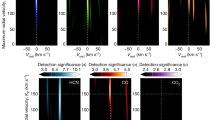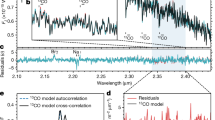Abstract
The atmospheres of the giant planets are reducing, being mainly composed of hydrogen, helium and methane. But the rings and icy satellites that surround these planets, together with the flux of interplanetary dust, could act as important sources of oxygen, which would be delivered to the atmospheres mainly in the form of water ice or silicate dust1,2,3,4,5,6,7. Here we report the detection, by infrared spectroscopy, of gaseous H2O in the upper atmospheres of Saturn, Uranus and Neptune. The implied H2O column densities are 1.5 × 1015, 9× 1013 and 3× 1014 molecules cm−2 respectively. CO2 in comparable amounts was also detected in the atmospheres of Saturn and Neptune. These observations can be accounted for by external fluxes of 105–107 H2O molecules cm−2 s−1 and subsequent chemical processing in the atmospheres. The presence of gaseous water and infalling dust will affect the photochemistry, energy budget and ionospheric properties of these atmospheres. Moreover, our findings may help to constrain the injection rate and possible activity of distant icy objects in the Solar System.
This is a preview of subscription content, access via your institution
Access options
Subscribe to this journal
Receive 51 print issues and online access
$199.00 per year
only $3.90 per issue
Buy this article
- Purchase on Springer Link
- Instant access to full article PDF
Prices may be subject to local taxes which are calculated during checkout


Similar content being viewed by others
References
Prather, M., Logan, J. A. & McElroy, M. B. carbon monoxide in Jupiter's upper atmosphere: an extraplanetary source. Astrophys. J. 223, 1072–1081 (1978).
Strobel, D. F. & Yung, Y. L. The Galilean satellites as a source of CO in the jovian upper atmosphere Icarus 37, 256–263 (1979).
Connerney, J. E. P. & Waite, J. H. New model of Saturn's ionosphere with an influx of water from the rings. Nature 312, 136–138 (1984).
Majeed, T. & McConnell, J. C. The upper ionospheres of Jupiter and Saturn. Planet. Space Sci. 39, 1715–1732 (1991).
Rizk, B. & Hunten, D. M. Solar heating of the Uranian mesopause by dust of ring origin. Icarus 88, 429–447 (1990).
Moses, J. I. Meteroid ablation in Neptune's atmosphere. Icarus 99, 368–383 (1992).
Morfill, G. E., Fechtig, H., Grün, E. & Goertz, C. K. Some consequences of meteoroid impacts on Saturn's rings. Icarus 55, 439–447 (1983).
de Graauw, T. et al. Observing with the ISO Short-Wavelength Spectrometer. Astron. Astrophys. 315, L49–L52 (1996).
Kessler, M. et al. The Infrared Space Observatory (ISO) mission. Astron. Astrophys. 315, L27–L30 (1996).
de Graauw, T. et al. First results of ISO-SWS observations of Saturn: detection of CO2, CH3C2H, C4H2and tropospheric H2O. Astron. Astrophys. 321, L13–L16 (1997).
Winkelstein, P. et al. Adetermination of the composition of the saturnain stratosphere using the IUE. Icarus 54, 309–318 (1983).
Fouchet, T. et al. HST spectro-imaging of Saturn and search for water from the rings. Bull. Am. Astron. Soc. 28, 1129 (1996).
Grün, E. et al. Interstellar dust in the heliosphere. Astron. Astrophys. 286, 915–924 (1994).
Grün, E., Zook, H. A., Fechtig, H. & Giese, R. H. Collisional balance of the meteoritic complex. Icarus 62, 244–272 (1985).
Humes, D. H. Results of Pioneer 1- and 11 meteroid experiments: interplanetary and near Saturn. J. Geophys. Res. 85, 5841–5852 (1980).
Samuelson, R. E. et al. CO2on Titan. J. Geophys. Res. 88, 8709–8715 (1983).
Lara, L. M., Lellouch, E., Lopez-Moreno, J. J. & Rodrigo, R. J. Vertical distribution of Titan's atmospheric neutral constituents. J. Geophys. Res. 101, 23261–23283 (1996).
Colwell, J. E. & Esposito, L. W. Origins of the rings of Uranus and Neptune. 1. Statistics of satellite disruptions. J. Geophys. Res. 97, 10227–10241 (1992).
Lellouch, E. in The Collision of Comet Shoemaker-Levy 9 and Jupiter (eds Noll, K. S., Weaver, H. A. & Feldman, P. D.) 213–242 (Cambridge Univ. Press, 1996).
Cuzzi, J. N. & Durisen, R. H. Bombardment of planetary rings of meteoroids: general formulation and effects of Oort cloud projectiles. Icarus 84, 467–501 (1990).
Broadfoot, L. A. et al. Ultraviolet spectrometer observations of Uranus. Science 233, 74–79 (1986).
Colwell, J. E. & Esposito, L. W. Anumerical model of the Uranian dust rings. Icarus 86, 530–560 (1990).
Colwell, J. E. & Esposito, L. W. Amodel of dust production in the Neptune ring system. Geophys. Res. Lett. 17, 1741–1744 (1990).
Foryta, D. W. & Sicardy, B. The dynamics of the Neptunian Adams ring's arcs. Icarus 123, 129–167 (1996).
Northrop, T. G. & Hill, J. R. The inner edge of Saturn's B ring. J. Geophys. Res. 88, 6102–6108 (1993).
Shemansky, D. E. et al. Detection of the hydroxyl radical in the Saturn magnetosphere. Nature 363, 329–331 (1993).
Crovisier, J. in Asteroids, Comets and Meteors (eds Milani, A. et al.) 313 (IAU Symp., Kluwer, Dordrecht, 1993).
Marten, A. et al. First observations of CH and HCN on Neptune and Urans at millimeter wavelengths and their implications for atmospheric chemistry. Astrophys. J. 406, 285–297 (1993).
Rosenqvist, J. et al. Millimeter-wave observations of Saturn, Uranus and Neptune: CO and HCN on Neptune. Astrophys. J. 392, L99–L102 (1992).
Noll, K. S. & Larson, H. A. The spectrum of Saturn from 1990 to 2230 cm−1: abundances of AsH3, CH3D, CO. GeH4, NH3and PH3. Icarus 89, 168–189 (1991).
Fernandez, J. A. Dynamical capture of physical decay of short-period comets. Icarus 64, 308–319 (1985).
Quinn, T., Tremaine, S. & Duncan, M. Planetary perturbations and the origin of short-period comets. Astrophys. J. 355, 667–679 (1990).
Smith, G. R. et al. Saturn upper's atmosphere from the Voyager 2 EUV solar and stellar occultation. J. Geophys. Res. 88, 8667–8678 (1983).
Atreya, S. K. et al.in Saturn (ed. Gehrels, T.) 239–277 (Univ. Arizona Press, Tucson, 1984).
Bishop, J., Atreya, S. K., Herbert, F. & Romani, P. Reanalysis of Voyager 2 UVS occultation at Uranus: hydrocarbon mixing ratios in the equatorial stratosphere. Icarus 88, 448–464 (1990).
Atneya, S. K., Sandel, B. R. & Romani, P. N. in Uranus (eds Bergstrahl, J. T., Miner, E. D. & Matthews, M. S.) 110–146 (Univ. Arizona Press, Tucson, 1990).
Romani, P. N., Bishop, J., Bézard, B. & Atreya, S. Methane photochemistry on Neptune: ethane and acetylene mixing ratios and haze production. Icarus 106, 442–463 (1993).
Bishop, J. S. et al. Voyager 2 ultraviolet spectrometer solar occultations at Neptune: constraints on the abundance of methane in the stratosphere. J. Geophys. Res. 97, 11681–11684 (1992).
Hubbard, W. B. et al. Structure of Saturn's mesosphere from the 28Sgr occultation. Icarus(submitted).
Strobel, D. F. et al.in Uranus (eds Bergstrahl, J. T., Miner, E. D. & Matthews, M. S.) 65–109 (Univ. Arizona Press, Tucson, 1990).
Acknowledgements
We thank A. Enzian, A. C. Levasseur-Regourd and B. Sicardy for discussion. This work was based on observations with ISO, an ESA project with instruments funded by ESA Member States (especially the PI countries: France, Germany, the Netherlands and the United Kingdom) and with the participation of ISAS and NASA. The SWS is a joint cooperation of the SRON and the MPE.
Author information
Authors and Affiliations
Corresponding author
Rights and permissions
About this article
Cite this article
Feuchtgruber, H., Lellouch, E., de Graauw, T. et al. External supply of oxygen to the atmospheres of the giant planets. Nature 389, 159–162 (1997). https://doi.org/10.1038/38236
Received:
Accepted:
Issue Date:
DOI: https://doi.org/10.1038/38236
This article is cited by
-
Evidence for auroral influence on Jupiter’s nitrogen and oxygen chemistry revealed by ALMA
Nature Astronomy (2023)
-
Jupiter Science Enabled by ESA’s Jupiter Icy Moons Explorer
Space Science Reviews (2023)
-
Solar System Science with the Orbiting Astronomical Satellite Investigating Stellar Systems (OASIS) Observatory
Space Science Reviews (2022)
-
Ice Giant Circulation Patterns: Implications for Atmospheric Probes
Space Science Reviews (2020)
-
The Deep Composition of Uranus and Neptune from In Situ Exploration and Thermochemical Modeling
Space Science Reviews (2020)
Comments
By submitting a comment you agree to abide by our Terms and Community Guidelines. If you find something abusive or that does not comply with our terms or guidelines please flag it as inappropriate.



